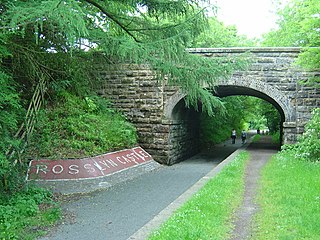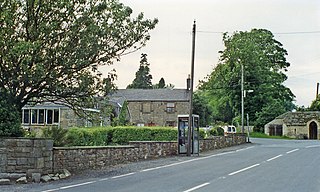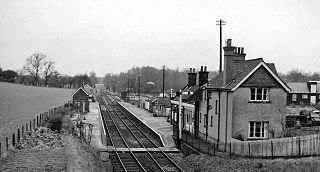Related Research Articles

There are eleven disused railway stations between Exeter St Davids and Plymouth Millbay, Devon, England. At eight of these there are visible remains. Of the eleven stations, South Brent and Plympton are subject of campaigns for reopening while Ivybridge station was replaced by another station on a different site.
Lydbrook Junction railway station is a disused railway station in England opened by the Ross and Monmouth Railway in 1873, it remained open for 91 years until 1964 when the line finally closed to freight, though passenger services ceased in 1959. The station was constructed in the hamlet of Stowfield approximately half a mile from Lydbrook and its viaduct on the Severn and Wye Railway. It was located approximately 4 miles and 34 chains along the railway from Ross-on-Wye station. In 1874 the Severn and Wye Railway opened a branch from Serridge Junction and Cinderford, passenger services commenced in 1875. All passenger trains along the S&W branch were withdrawn from 1929.

Hawick railway station served the town of Hawick, Scottish Borders, Scotland from 1849 to 1969 on the Waverley Route.
Penton railway station served the parish of Penton from 1862 to 1969 on the Border Union Railway.
The Edinburgh, Loanhead and Roslin Railway was a railway line south of Edinburgh, Scotland, built primarily to serve mineral workings, although passenger trains were operated. It is also known as the Glencorse Branch of the North British Railway. It opened from a junction at Millerhill on the Waverley Route, to Roslin in 1874 and was extended to a location near Penicuik to serve Glencorse Barracks and a colliery in 1877 and to Penicuik Gas Works in 1878.
The Peebles Railway was a railway company that built a line connecting the town of Peebles in Peeblesshire, Scotland, with Edinburgh. It opened on 4 July 1855, and it worked its own trains.
The Esk Valley Railway was a short branch line built to serve industry in the valley of the River North Esk, south of Edinburgh in Scotland. The terminus was Polton. The line opened on 15 April 1867
The Penicuik Railway was a railway line in Midlothian, Scotland, serving paper mills located on the River North Esk. It opened in 1872 and a substantial residential passenger traffic built up. The line was 4 1/2 miles long.

Rosslynlee railway station served the village of Roslin, Midlothian, Scotland from 1855 to 1962 on the Peebles Railway.

Peebles railway station was the second site of the railway station in Peebles, Peeblesshire, Scotland from 1864 to 1962 on the Peebles Railway.

Rosslyn Castle railway station served the village of Roslin, Midlothian, Scotland from 1872 to 1959 on the Penicuik Railway.

Chollerton railway station served the village of Chollerton, Northumberland, England from 1859 to 1958 on the Border Counties Railway.

Colinton railway station was opened in 1874 and served the area of the then village of Colinton that now forms part of the city of Edinburgh, with Colinton House nearby. Although primarily built as a goods line to serve the many mills on the Water of Leith, a passenger service was provided by the Caledonian Railway using the Balerno Loop and after grouping by the London, Midland and Scottish Railway, seeing formal closure to passenger traffic shortly after nationalisation.

Tow Law railway station served the town of Tow Law, County Durham, England, from 1847 to 1965 on the Stanhope and Tyne Railway.

Boncath railway station served the village of Boncath, Pembrokeshire, Wales, from 1886 to 1963 on the Whitland and Cardigan Railway.

Llanfyrnach railway station served the village of Llanfyrnach, Pembrokeshire, Wales, from 1875 to 1963 on the Whitland and Cardigan Railway.

Braughing railway station served the village of Braughing, Hertfordshire, England, from 1863 to 1964 on the Buntingford branch line.
Loanhead railway station served the town of Loanhead, Midlothian, Scotland, from 1874 to 1968 on the Edinburgh, Loanhead and Roslin Railway.

Roslin railway station served the village of Roslin, Midlothian, Scotland, from 1874 to 1959 on the Edinburgh, Loanhead and Roslin Railway.
Glencorse railway station served the parish of Glencorse, Midlothian, Scotland, from 1877 to 1959 on the Edinburgh, Loanhead and Roslin Railway.
References
- ↑ Quick, M E (2002). Railway passenger stations in England, Scotland and Wales - a chronology. Richmond: Railway and Canal Historical Society. p. 194. OCLC 931112387.
- ↑ "Disused Stations: Gilmerton Station". Disused Stations. Retrieved 19 September 2021.
| Preceding station | Disused railways | Following station | ||
|---|---|---|---|---|
| Millerhill Line and station closed | Edinburgh, Loanhead and Roslin Railway | Loanhead Line and station closed |